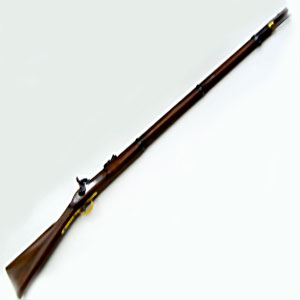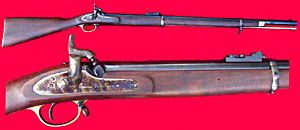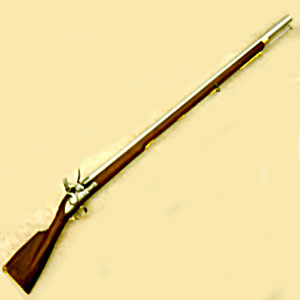 The Enfield Rifle is actually called the Pattern 1853 Enfield Rifle Musket. It was introduced by the British East India Company, under the Bengal Army. In short, the rifle is just termed as P-53 rifle. The historical furore that was raised in this regard was the use of a special kind of cartridge, which was initiated in early-1857. The rifle needed an extraordinary kind of loading of a cartridge in the magazine, and hence the soldiers while in the ensuing fight, had to bite off the outer covering of the cartridge while loading it down into the rifle`s muzzle. And this covering was the principal centre of all attraction, which had made the Indian soldiers to rise up and make way for the historic revolt of 1857. It was rumoured that the protective covering was lubricated with the fat of either pig or cow, making way for a barrage of protests by the Hindus and Muslims to not make use of the rifle and the cartridge.
The Enfield Rifle is actually called the Pattern 1853 Enfield Rifle Musket. It was introduced by the British East India Company, under the Bengal Army. In short, the rifle is just termed as P-53 rifle. The historical furore that was raised in this regard was the use of a special kind of cartridge, which was initiated in early-1857. The rifle needed an extraordinary kind of loading of a cartridge in the magazine, and hence the soldiers while in the ensuing fight, had to bite off the outer covering of the cartridge while loading it down into the rifle`s muzzle. And this covering was the principal centre of all attraction, which had made the Indian soldiers to rise up and make way for the historic revolt of 1857. It was rumoured that the protective covering was lubricated with the fat of either pig or cow, making way for a barrage of protests by the Hindus and Muslims to not make use of the rifle and the cartridge.
The primary motivation behind Mangal Pandey`s (the first freedom fighter to cry for independence) behaviour is credited to a new type of bullet cartridge used in the Enfield P-53 Rifle, which was to be introduced in the Bengal Army in the year 1856.
The cartridge was rumored to having been greased with animal fat (principally pig fat and cow fat, the animals which are not consumed by Muslims and Hindus respectively, the former being repulsive to Muslims and the latter a holy animal of the Hindus). The cartridges had to be bitten at one end prior to its usage. The mutineers were of the view that this was a intended act of the British, with the aim to besmirch their religions.
 Commandant Wheeler of the 34th BNI was known as a fervent Christian preacher, and this may also have bore upon the Company`s behaviour. The husband of Captain Wilma Halliday of 56th BNI had the Bible printed in Urdu and Nagri and distributed among the sepoys, thus arousing suspicions amongst them that the British had a primary objective to convert them to Christianity.
Commandant Wheeler of the 34th BNI was known as a fervent Christian preacher, and this may also have bore upon the Company`s behaviour. The husband of Captain Wilma Halliday of 56th BNI had the Bible printed in Urdu and Nagri and distributed among the sepoys, thus arousing suspicions amongst them that the British had a primary objective to convert them to Christianity.
The 19th Native Infantry Regiment is important in this context, because it was the regiment charged with testing the new cartridges on February 26, 1857. However, till the time of mutiny, the guns had not been supplied to them and the cartridges in the magazine of the regiment were as free of grease as they had been through the preceding half-century. However, the paper used in wrapping the cartridges was of a different colour, giving rise to suspicions. The non-commissioned officers of the regiment denied to accept the cartridges on the 26th February. This information being communicated to the commanding officer, Colonel Mitchell, he took it upon himself to try to convince the sepoys that the cartridges were no different from those they had been habituated to and that they need not bite it. He concluded his exhortation with a plea to the native officers to espouse the honour of the regiment and a threat to court-martial such sepoys who refused to accept the cartridge.
The P-53 was officially known as the Pattern 1853 Enfield Rifle Musket. Introduced in the British Army by the War Department during 1854 in the Crimean War, they proved extremely successful at a range of 50 to 300 yards (270 m). It was introduced in the Bengal Army by the British East India Company in early-1857.
 The P-53 Enfield rifle made use of a Metford-Pritchitt cartridge that necessitated the use of a heavy paper tube containing 2½ drams (68 grains) of musket powder and a 530-grain (34 g), pure lead bullet. As the bullet contained no annular grease rings like the French and American minie ball bullets introduced in 1847, it was wrapped with a strip of greased paper to facilitate loading. The cartridge itself was overlaid with a thin mixture of beeswax and mutton tallow for waterproofing.
The P-53 Enfield rifle made use of a Metford-Pritchitt cartridge that necessitated the use of a heavy paper tube containing 2½ drams (68 grains) of musket powder and a 530-grain (34 g), pure lead bullet. As the bullet contained no annular grease rings like the French and American minie ball bullets introduced in 1847, it was wrapped with a strip of greased paper to facilitate loading. The cartridge itself was overlaid with a thin mixture of beeswax and mutton tallow for waterproofing.
To load the P-53 Enfield rifle, the sepoy had to first bite off the back of the cartridge to pour the powder down the barrel. A soldier then needed to invert the tube (the projectile was placed in the cartridge base up), push the end-portion into the muzzle to the estimated depth of the bullet and tear off the remaining paper. The bullet could then be easily be shoved on top of the charge.
Since Hindus consider cows as sanctified and Muslims regard pigs as filthy, native sepoys were anticipated to have qualms in its utilisation. The company thus kept this as a suppressed fact. Hence, when it came out as a rumour, it had an even more destructive consequence, as all kinds of rumours started circularising. For example, it was thought that the British had designs to make their sepoys outcaste in the society in order to compel them to convert to Christianity. Another rumour said the British had debased the wheat flour distributed to the sepoys with powdered bone-dust of bullocks.
The matter could have been aggravated by the fact that an overpowering number of sepoys in the Bengal Native Infantry were Brahmins from Awadh, Purvanchal and Western Bihar. As Brahmins are generally zealous Hindus and consequently vegetarians, they are not supposed to eat or touch meat, the opposition was even stronger.
Later, the British reflected to reduce the displeasure by allowing the sepoys to use their own grease made of ghee (clarified butter). Lord Canning approved a proposal of Major-General Hearsey to this effect. However, the proposal was voted down by the Meerut-based Adjutant-General of the Army Colonel C. Chester, who felt it would be equivalent to an admittance of guilt and could therefore worsen the matter. He untruly claimed that the sepoys had been using cartridges greased with mutton fat for years and that there was therefore no reason to succumb now. This claim was grossly fake, as native sepoys had till then only used Brown Bess muskets for which un-smeared paper cartridges were utilised. The Government let itself be persuaded and repealed the order allowing the usage of ghee.



















